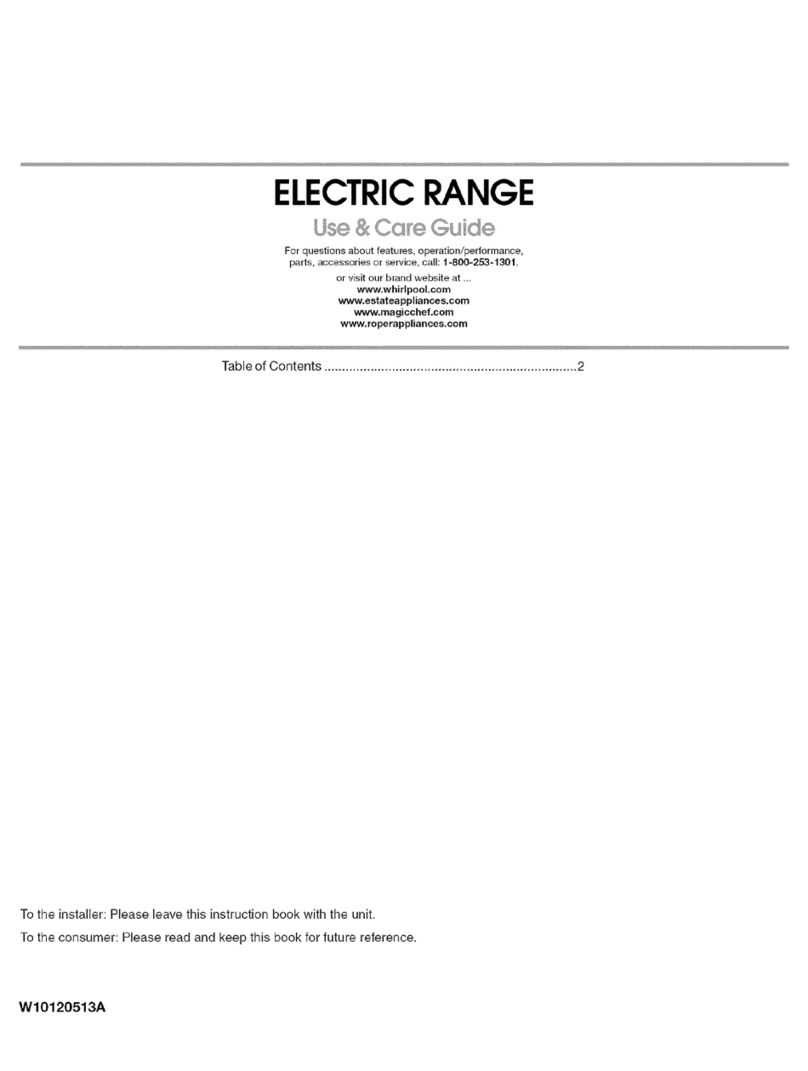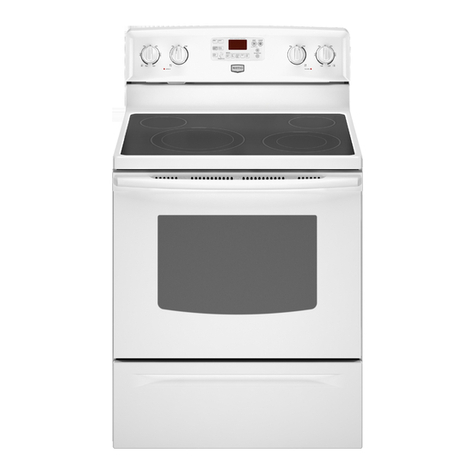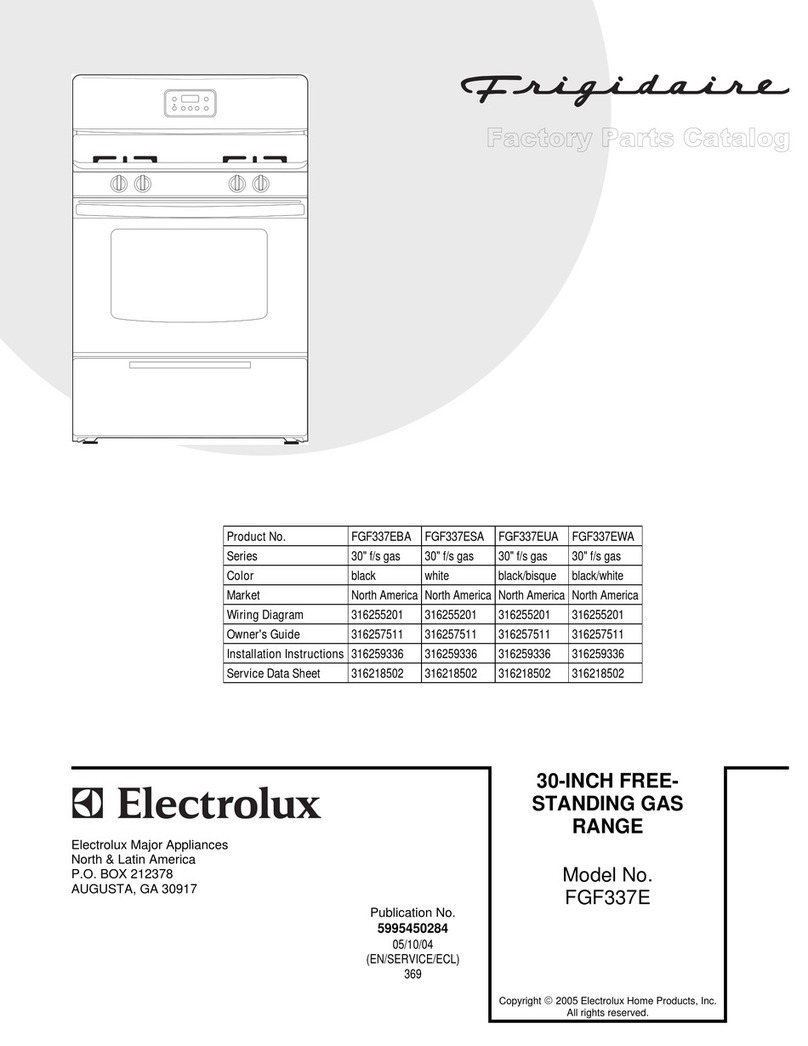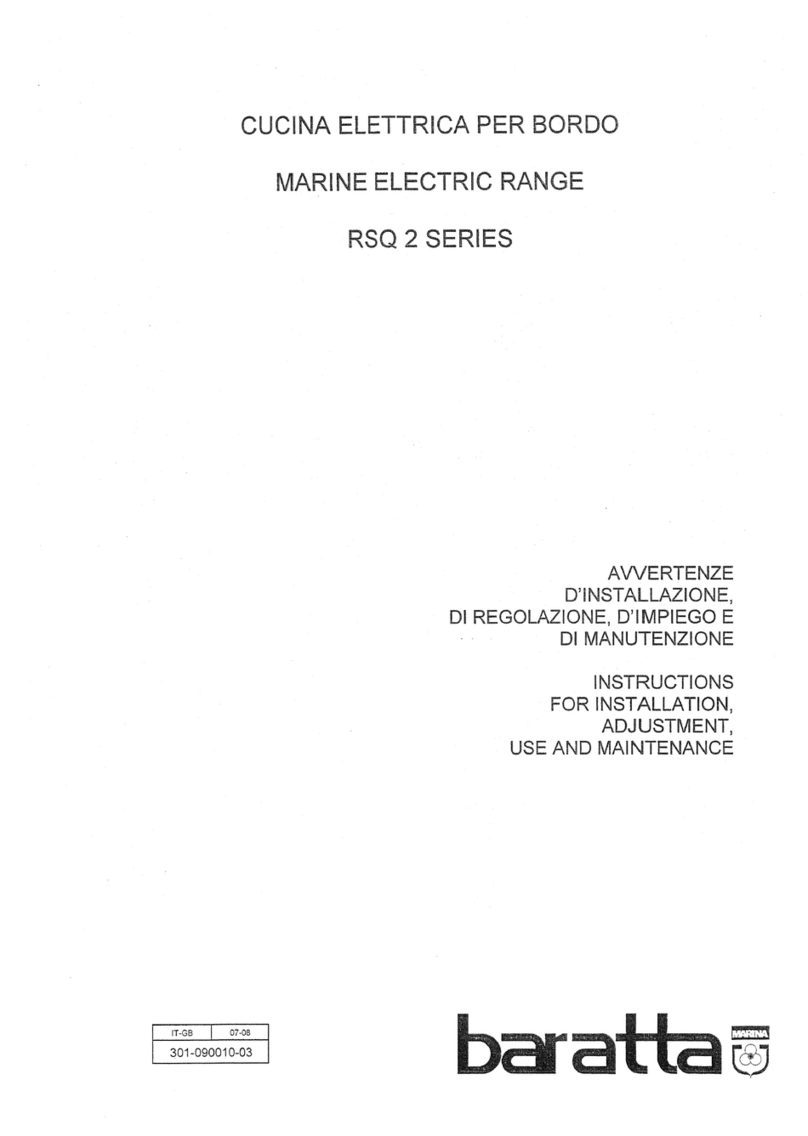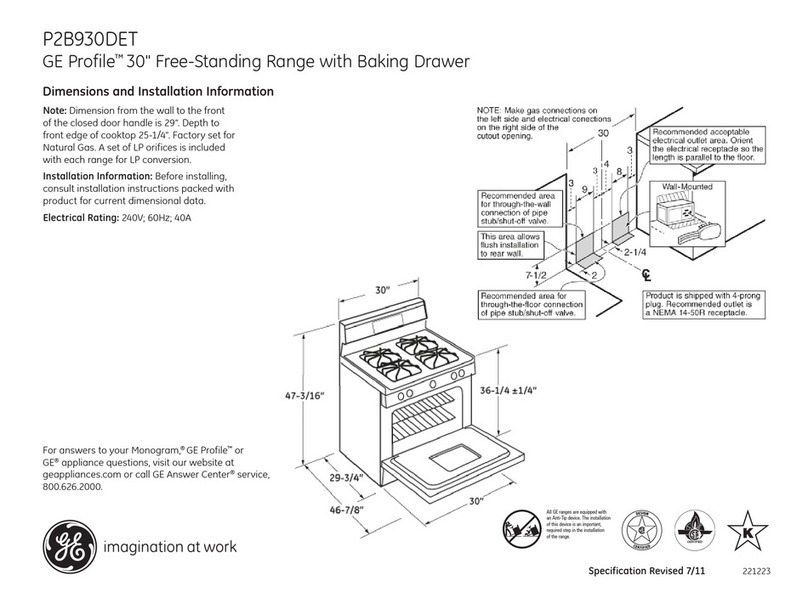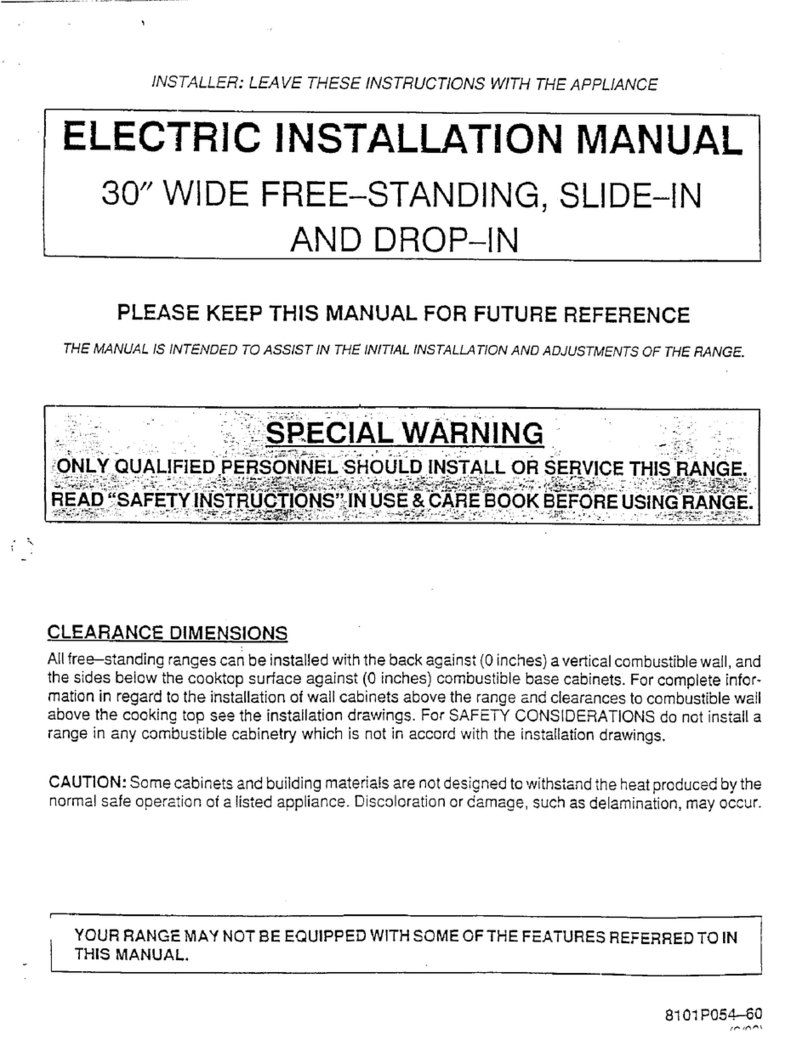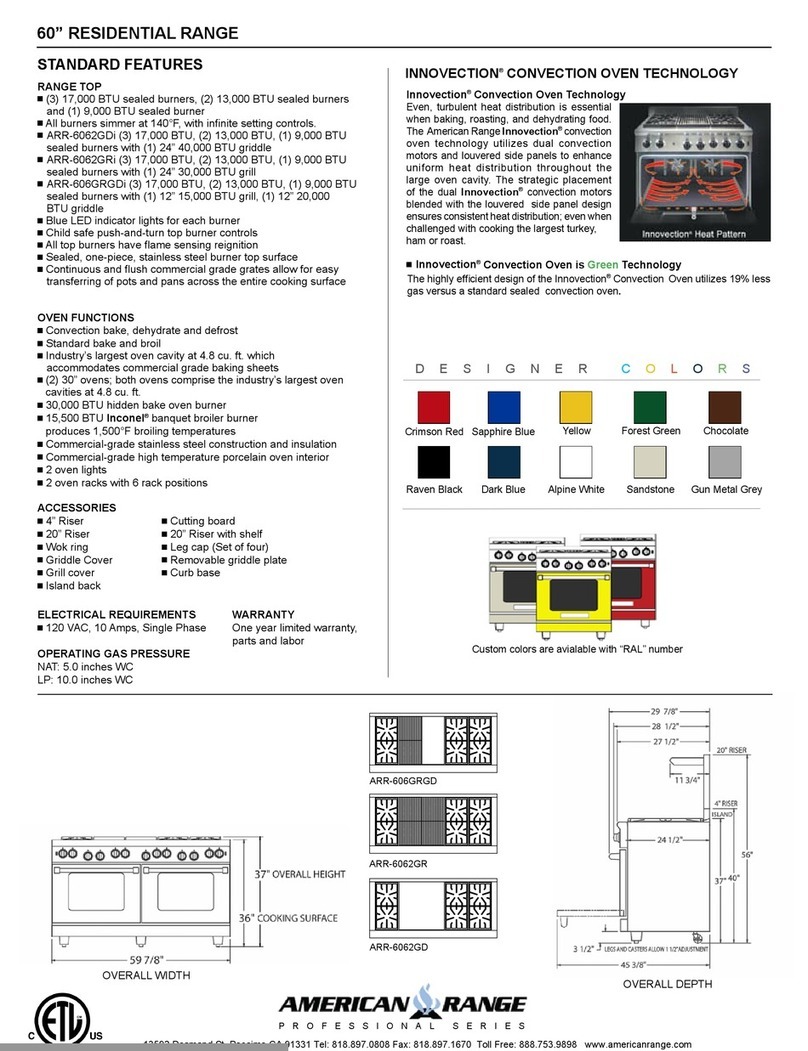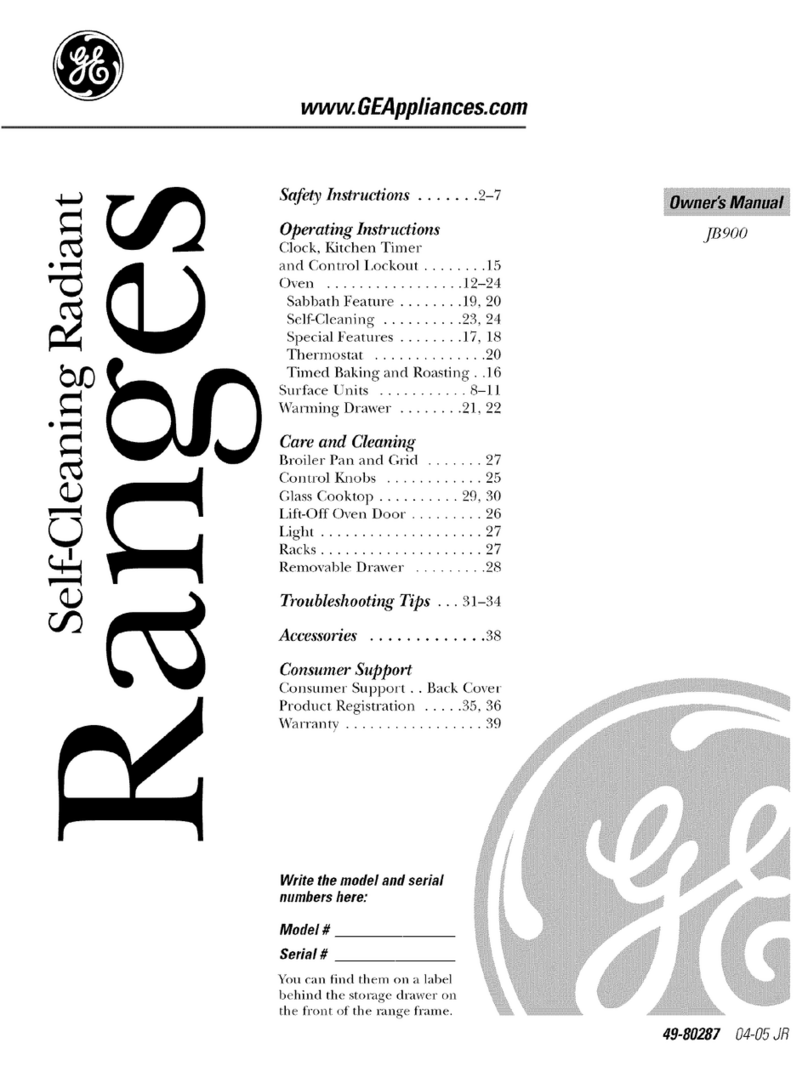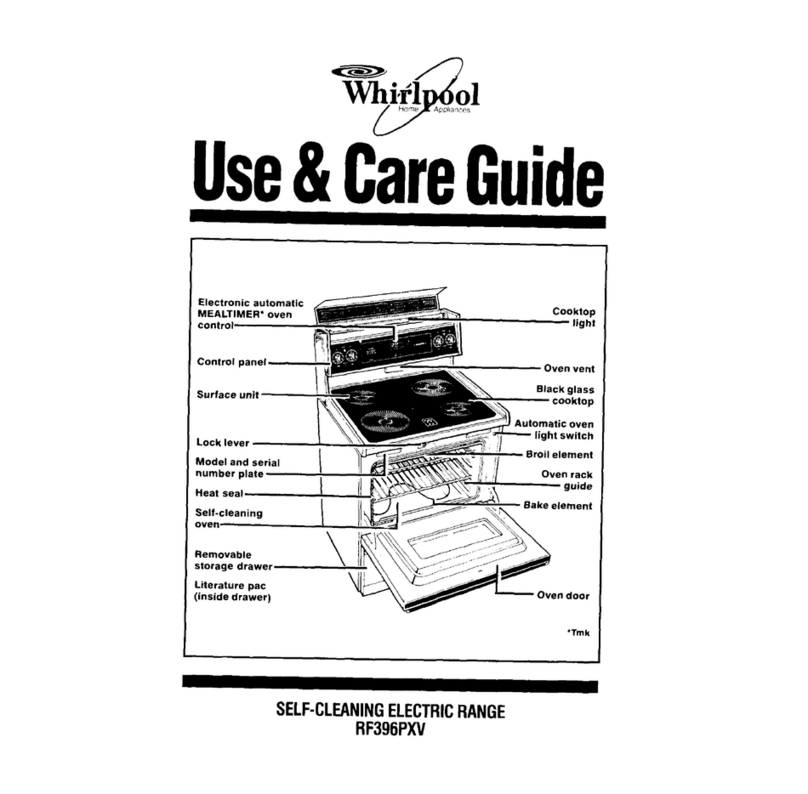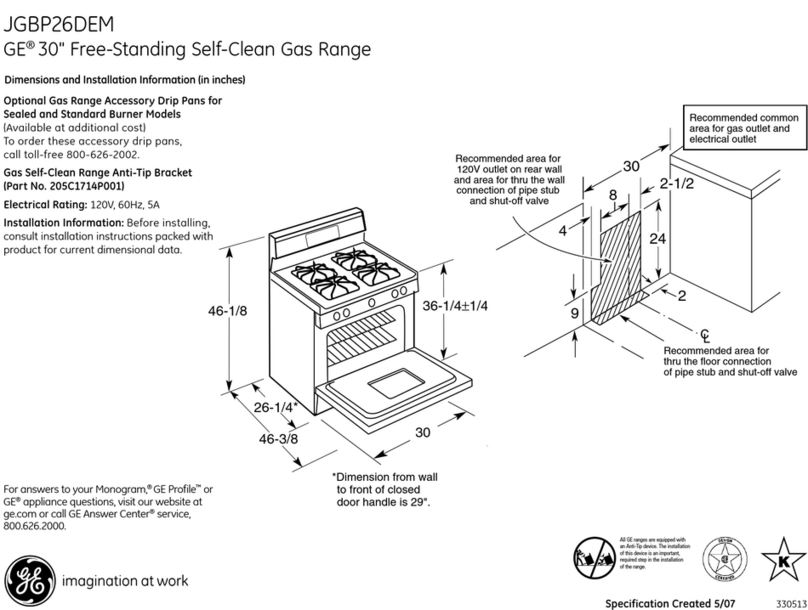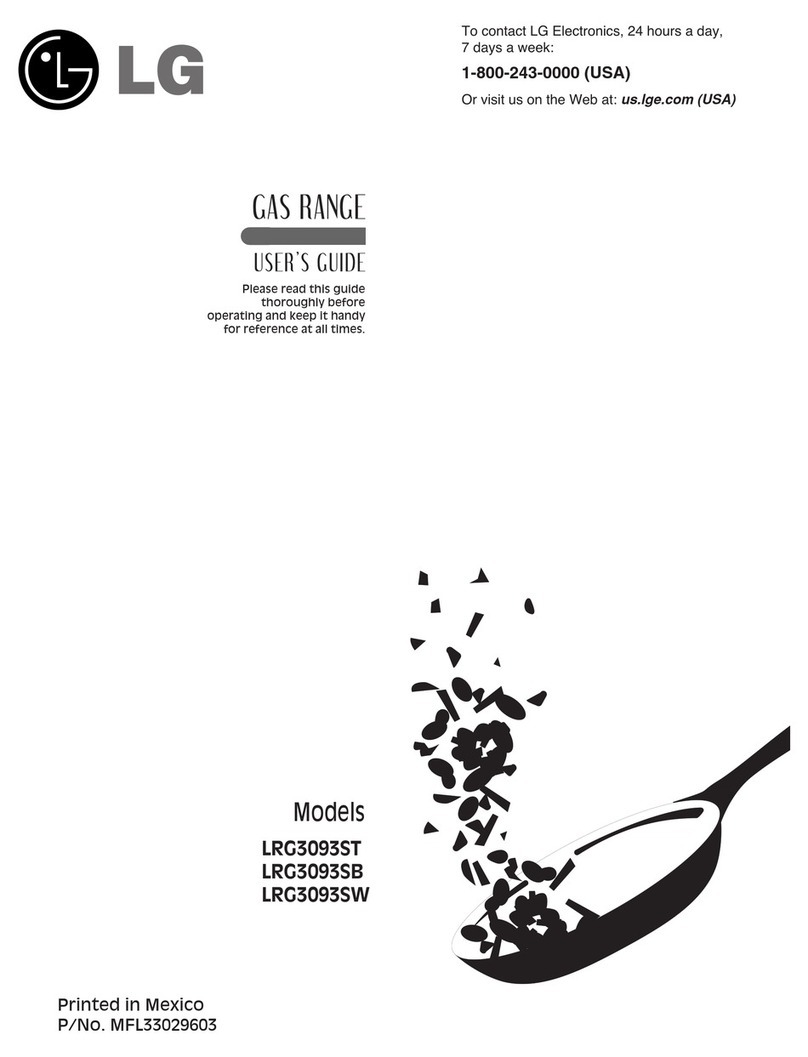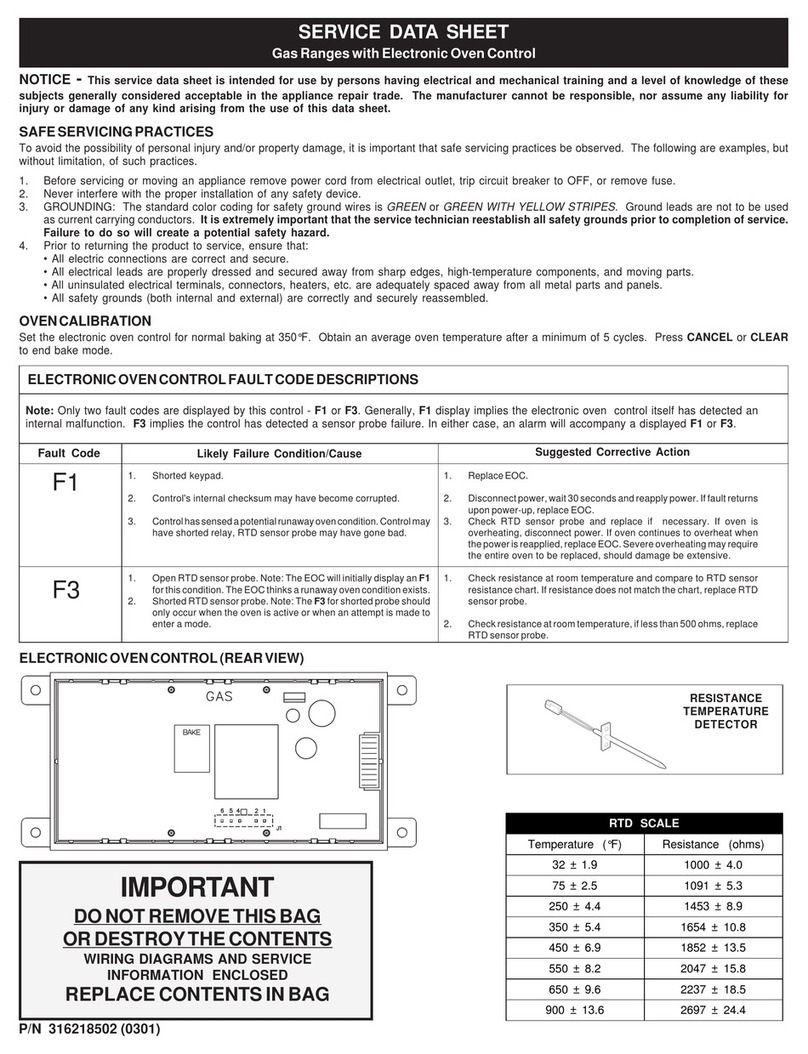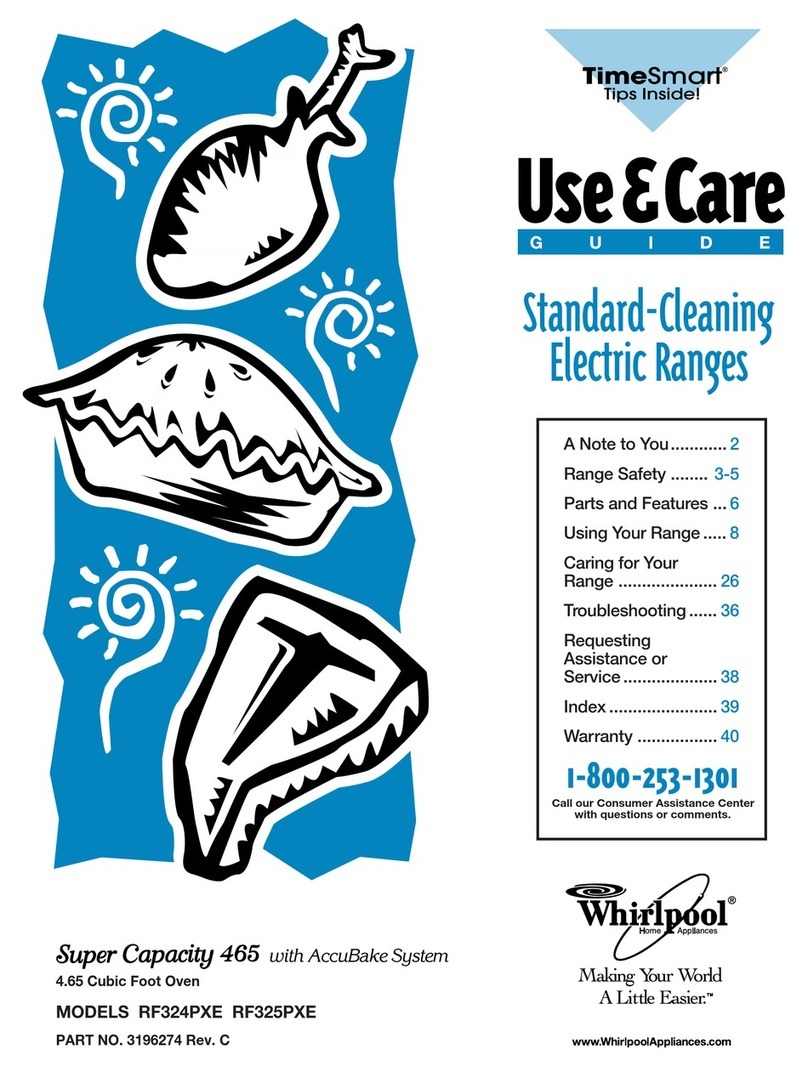Roper FGP325G User manual

UseSCare
A
Note
to
You.
...2
Range
Safety.
...
3
Parts
and
Features
■
■
■
Using
Your
Range
.
...6
Caring
for
Your
Range
.
.17
Troubleshooting.
.23
Requesting
Assistance
or
Service.
.25
Index.
.27
Warranty.
.28
TO
THE
INSTALLER:
PLEASE
LEAVE
THIS
INSTRUCTION
BOOK
WITH
THE
UNIT.
TO
THE
CONSUMER:
PLEASE
READ
AND
KEEP
THIS
BOOK
FOR
FUTURE
REFERENCE.

ANoieidYou
Thsuk
you
for
buyinf
a
ROPER®
appliance.
Your
ROPER
range
gives
you
all
the
functionality
of
name
brand
appiiances
at
a
value
price.
To
ensure
that
you
enjoy
years
of
troubie-free
operation,
we
deveioped
this
Use
and
Care
Guide.
It
is
full
of
valuable
information
about
how
to
operate
and
maintain
your
appliance
properly
and
safely.
Please
read
it
carefully.
Also,
please
complete
and
mail
the
Product
Registration
Card
provided
with
your
appliance.
The
card
helps
us
notify
you
about
any
new
information
on
your
appliance.
Pieisi
record
your
itiodirs
ipformation.
Whenever
you
call
to
request
service
for
your
appliance,
you
need
to
know
your
complete
model
number
and
serial
number.
You
can
find
this
informa
tion
on
the
model
and
serial
number
label/plate
(see
the
diagram
in
the
“Parts
and
Features”
section).
Please
also
record
the
purchase
date
of
your
appliance
and
your
dealer’s
name,
address,
and
telephone
number.
Keep
this
book
and
the
sales
slip
together
in
a
safe
place
for
future
reference.
It
is
important
for
you
to
save
your
sales
receipt
showing
the
date
of
purchase.
Proof
of
purchase
will
assure
you
of
in-warranty
service.
Model
Number
Serial
Number
_
Purchase
Date
Dealer
Name
_
Dealer
Address
Dealer
Phone
---1
WARNING:
If
the
information
in
this
manual
is
not
followed
exactly,
a
fire
or
explosion
may
result
causing
property
damage,
personal
injury
or
death.
-
Do
not
store
or
use
gasoline
or
other
flammable
vapors
and
liquids
in
the
vicinity
of
this
or
any
other
appliance.
-
WHAT
TO
DO
IF
YOU
SMELL
GAS
•
Do
not
try
to
light
any
appliance.
•
Do
not
touch
any
electrical
switch;
do
not
use
any
phone
in
your
building.
•
Immediately
call
your
gas
supplier
from
a
neighbor’s
phone.
Foliow
the
gas
supplier’s
instructions.
•
If
you
cannot
reach
your
gas
supplier,
call
the
fire
department.
-
Instaliation
and
service
must
be
performed
by
a
qualified
installer,
service
agency
or
the
gas
supplier.
2

Range
Safety
Youf
safety
and
the
safety
of
others
Is
very
important.
We
have
provided
many
important
safety
messages
in
this
manuai
and
on
your
appliance.
Aiways
read
and
obey
all
safety
messages.
0
This
is
the
safety
alert
symbol.
This
symbol
alerts
you
to
hazards
that
can
kill
or
hurt
you
and
others.
All
safety
messages
will
be
preceded
by
the
safety
alert
symbol
and
the
word
“DANGER"
or
"WARNING.”
These
words
mean;
ADANGER
AWARNING
You
will
be
killed
or
seriously
injured
if
you
don’t
follow
instructions.
You
can
be
killed
or
seriously
injured
if
you
don’t
follow
instructions.
All
safety
messages
will
identify
the
heizard,
tell
you
how
to
reduce
the
chance
of
injury,
and
tell
you
what
can
happen
if
the
instructions
are
not
followed.
AWARNING
J
Anti-Tip
Bracket
Range
Foot
Tip
Over
Hazard
A
child
or
adult
can
tip
the
range
and
be
killed.
Connect
anti-tip
bracket
to
rear
range
foot.
Reconnect
the
anti-tip
bracket,
if
the
range
is
moved.
See
the
installation
instructions
for
details.
Failure
to
follow
these
instructions
can
result
in
death
or
serious
burns
to
children
and
adults.
Making
sure
the
anti-tip
bracket
is
installed:
•
Slide
range
forward.
•
Look
for
the
anti-tip
bracket
securely
attached
to
floor.
•
Slide
range
back
so
rear
range
foot
is
under
anti-tip
bracket.
3

IMPORTANT
SAFETY
INSTRUCTIONS
WARNING:
To
reduce
the
risk
of
fire,
electrical
shock,
injury
to
persons,
or
damage
when
using
the
range,
foiiow
basic
precautions,
inciuding
the
following:
•WARNING
-
TO
REDUCE
THE
RISK
OF
TIPPING
OF
THE
RANGE,
THE
RANGE
MUST
BE
SECURED
BY
PROPERLY
INSTALLED
ANTI-TIP
DEVICES.
TO
CHECK
IF
THE
DEVICES
ARE
INSTALLED
PROPERLY,
SLIDE
RANGE
FORWARD,
LOOK
FOR
ANTI-TIP
BRACKET
SECURELY
ATTACHED
TO
FLOOR,
AND
SLIDE
RANGE
BACK
SO
REAR
RANGE
FOOT
IS
UNDER
ANTI-TIP
BRACKET.
•
CAUTION
—
Do
not
store
items
of
interest
to
children
in
cabinets
above
a
range
or
on
the
backguard
of
a
range
-chiidren
climbing
on
the
range
to
reach
items
couid
be
seriously
injured.
•
Proper
Installation
-
The
range,
when
installed,
must
be
electrically
grounded
in
accordance
with
local
codes
or,
in
the
absence
of
local
codes,
with
the
National
Electrical
Code,
ANSI/NFPA
70.
Be
sure
the
range
is
properly
installed
and
grounded
by
a
qualified
technician.
•This
range
is
equipped
with
a
three-prong
grounding
plug
for
your
protection
against
shock
hazard
and
should
be
plugged
directly
into
a
properly
grounded
receptacle.
Do
not
cut
or
remove
the
grounding
prong
from
this
plug.
•
Disconnect
the
electrical
supply
before
servicing
the
appliance.
•
Never
Use
the
Range
for
Warming
or
Heating
the
Room.
•
Injuries
may
result
from
the
misuse
of
appliance
doors
or
drawers
such
as
stepping,
leaning,
or
sitting
on
the
doors
or
drawers.
•
Maintenance
-
Keep
range
area
clear
and
free
from
combustible
materials,
gasoline,
and
other
flammable
vapors
and
liquids.
•
Storage
in
or
on
the
Range
-
Flammable
materials
should
not
be
stored
in
an
oven
or
near
surface
units.
•Top
burner
flame
size
should
be
adjusted
so
it
does
not
extend
beyond
the
edge
of
the
cooking
utensil.
For
self-cleaning
ranges
-
•
Before
Self-Cleaning
the
Oven
-
Remove
broiler
pan
and
other
utensils.
Wipe
off
all
excessive
spillage
before
initiating
the
cleaning
cycle.
-
SAVE
THESE
INSTRUCTIONS
-

5

UsMG
Your
Range
Usiif
tkcofttrelliiik
Your
range
comes
with
electric
ignitors.
Electric
ignitors
automatically
light
the
burners
each
time
you
turn
the
control
knobs
to
LIGHT.
•
Place
a
filled
pan
on
the
burner
grate
before
turning
on
the
surface
burner.
Do
not
operate
a
burner
for
extended
periods
of
time
without
having
cookware
on
the
grate.
•
Push
in
the
control
knob
and
turn
it
counter¬
clockwise
to
the
LIGHT
position.
The
clicking
sound
is
the
ignitor
sparking.
Make
sure
the
burner
has
lit.
•
To
stop
the
clicking
sound
after
the
burner
lights,
turn
the
control
knob
to
the
cook
setting
you
want.
You
can
set
the
control
knob
any-
LOW.
tors
will
click
at
the
same
I
time.
However,
the
burner
with
the
control
knob
turned
to
LIGHT
is
the
one
that
will
ignite.
6
Itirner
lea!
settlifs
Use
the
following
chart
as
a
guide.
SETTING
RECOMMENDED
USE
LIGHT
•
To
light
the
burner.
j
HIGH
•
To
start
food
cooking.
•
To
bring
liquid
to
a
boil.
Mid-range
•
To
hold
a
boil.
(between
HIGH
•
To
fry
chicken
or
pancakes.
and
LOW)
•
For
gravy,
pudding,
and
icing,
j
•
To
cook
large
amounts
of
vegetables.
LOW
•
To
keep
food
warm.
•
To
melt
chocolate
or
butter.
j
•
To
simmer.
{
NOTE:
Do
not
leave
empty
cookware,
or
cookware
which
has
boiled
dry,
on
a
hot
surface
burner.
The
cookware
could
overheat,
causing
damage
to
the
cookware
or
cooking
product.
I
Easy
ways
to
save
enerfi
.
|
•
To
help
shorten
your
cooking
time,
use
the
least
amount
of
liquid
possible.
•
Preheat
your
pots
and
pans
only
when
recommended
and
for
the
shortest
time
possible.
•
Start
your
food
on
a
higher
heat
setting,
then
turn
the
control
to
a
lower
setting
to
finish
cooking.

USING
YOUR
RANCE
Using
THE
SURFACE
BURNERS
(CONT.)
I
In
ease
§f
a
prolonf
ed
power
failure
j
You
can
manually
light
surface
burners.
Hold
a
lit
I
match
near
a
burner
and
turn
the
control
knob
to
J
the
LIGHT
position.
After
the
burner
lights,
turn
the
control
knob
to
the
setting
you
want.
I
Hws
catiniiif
tnforirigfieii
!
The
large
diameter
of
most
water-bath
or
pressure
i
canners
combined
with
high
heat
settings
for
long
I
periods
of
time
can
cause
damage
to
the
cooktop.
i
To
protect
your
range:
I
e
For
best
results,
use
a
canner
which
can
be
j
centered
over
the
surface
burner.
j
•
Do
not
place
your
canner
on
2
surface
burners
at
the
same
time.
•
Start
with
hot
water.
This
reduces
the
time
the
control
is
set
on
high.
Reduce
the
heat
setting
to
the
lowest
position
needed
to
maintain
a
boil
or
required
pressure
levels
in
a
pressure
canner.
•
Refer
to
your
canner
manual
for
specific
instructions.
For
up-to-date
information
on
canning,
contact
your
local
U.S.
Government
Agricultural
Department
Extension
Office
or
companies
who
manufacture
home
canning
products.
Usilif
tie
rif
tit
tmkwm
mikes
a
bif
ifftreiici
•
The
pan
should
have
a
flat
bottom,
straight
sides,
and
a
well-fitting
lid.
•
Choose
medium
to
heavy
gauge
(thickness)
cookware.
•
The
pan
material
(metal
or
glass)
affects
how
quickly
and
evenly
the
pan
heats.
•
When
using
glass
or
ceramic
cookware,
check
to
make
sure
it
is
suitable
for
use
on
surface
burners.
•
To
avoid
tipping,
make
sure
pots
and
pans
are
centered
on
the
grates.
Characteristics
of
cookware
mattrials
The
pan
material
affects
how
fast
heat
transfers
from
the
surface
cooking
area
through
the
pan
material
and
how
evenly
heat
spreads
over
the
pan
bottom.
Choose
pans
that
provide
the
best
cooking
results.
Aluminum
•
Heats
quickly
and
evenly.
•
Use
for
all
t^es
of
cooking.
•
Medium
or
heavy
thickness
is
best
for
most
cooking.
•
Used
as
a
core
or
base
in
cooloware
to
provide
even
heating.
Cast
iron
•
Heats
slowly
and
evenly.
•
Good
for
browning
and
frying.
•
Maintains
heat
for
slow
cooking.
•
Can
be
coated
with
porcelain
enamel.
Ceramic
or
ceramic
glass
•
Heats
slowly
and
unevenly.
•
Use
on
low
to
medium
settings.
•
Follow
manufacturer’s
instructions.
Copper
•
Heats
very
quickly
and
evenly.
•
Used
as
a
core
or
base
in
cookware
to
provide
even
heating.
Earthenware
•
Can
be
used
for
cooktop
cooking
if
recommended
by
the
manufacturer.
•
Use
on
low
settings.
Porcelain
enamel-on-steel
or
enamel-on-cast
iron
•
See
cast
iron
and
stainless
steel.
Stainless
steel
•
Heats
quickly
but
unevenly.
•
A
core
or
base
of
aluminum
or
copper
on
the
cookware
provides
even
heating.
•
Can
be
coated
with
porcelain
enamel.
7

Positioninf
racks
and
pans
Place
the
oven
racks
where
you
need
them
before
turning
on
the
oven.
•
To
move
a
rack,
pull
it
out
to
the
stop
position,
raise
the
front
edge
and
lift
it
out.
•
Be
sure
the
rack(s)
is
level.
•
Use
pot
holders
or
oven
mitts
to
protect
your
hands
if
rack(s)
must
be
moved
while
the
oven
is
hot.
•
For
best
performance,
cook
on
one
rack.
Place
the
rack
so
the
top
of
the
food
will
be
centered
in
the
oven.
•
When
cooking
with
two
racks,
arrange
the
racks
on
the
2nd
and
4th
rack
guides.Two
sheets
of
cookies
may
be
baked
if
sheets
are
switched
at
approximately
three
quarters
of
the
total
bake
time.
Increase
baking
time,
if
necessary.
•
For
best
results
allow
2
inches
of
space
around
each
pan
and
between
pans
and
oven
walls.
Where
to
place
pans:
i
WHEN
YOU
HAVE
PLACE
j
1
pan
In
center
of
the
oven
rack.
i
2
pans
i
Side
by
side
or
slightly
staggered.
!
j
3
or
4
pans
In
opposite
comers
on
|
each
oven
rack.
Stagger
j
pans
so
no
pan
is
directly
j
over
another.
Extra
oven
rack
pesitiii?
(foastiif
rack)
Use
this
rack
position
when
roasting
food
too
large
to
be
placed
on
the
first
rack
position.
For
proper
roasting,
follow
these
guidelines:
•
To
avoid
spillage,
remove
food
before
pulling
out
the
rack.
•
Tilt
the
rack
up
at
the
front
before
pulling
it
over
the
door.
•
Use
an
adequate
amount
of
liquid
in
the
pan
(meat
juices
or
water)
so
your
food
does
not
get
overdone.
8

USING
YOUR
RANGE
Using
aluminum
foil
•
Use
aluminum
foil
to
catch
spillovers
from
pies
or
casseroles
by
placing
foil
on
the
oven
rack
below.
Foil
should
be
turned
up
at
edges
and
be
at
least
1
inch
iarger
than
dish.
•
Do
not
cover
the
entire
rack
with
aluminum
foil.
It
will
reduce
air
circula¬
tion
and
give
you
poor
cooking
results.
•
Do
not
line
the
oven
bottom
with
foil
or
other
liners.
It
could
affect
the
oven
surface
as
well
as
the
quality
of
your
baking.
•
Place
tent-shaped
foil
loosely
over
meat
or
poultry
to
slow
down
surface
browning
for
long
term
roasting.
Remove
foil
for
the
last
30
minutes.
•
Use
narrow
strips
of
foil
to
shield
piecrust
edges
if
browning
too
quickly.
BAKEWARE
CHOICES
Baking
performance
is
affected
by
the
type
of
bakeware
used.
Use
the
bakeware
size
recommended
in
the
recipe.
BAKEWARE
TYPE
BEST
USED
FOR
GUIDELINES
Light
colored
aluminum
•
Light
golden
crusts
•
Even
browning
•
Use
temperature
and
time
recommended
in
recipe.
Dark
aluminum
and
other
bakeware
with
dark,
dull,
and/or
non-stick
finish
•
Brown,
crisp
crusts
•
May
reduce
baking
temperature
25°F.
•
Use
suggested
baking
time.
•
Use
temperature
and
time
recommended
in
recipe
for
pies,
breads,
and
casseroles.
•
Place
rack
in
center
of
oven.
Ovenproof
glassware,
ceramic
glass,
or
ceramic
•
Brown,
crisp
crusts
•
May
reduce
baking
temperature
25°F.
Insulated
cookie
sheets
or
baking
pans
•
Little
or
no
bottom
browning
•
Place
in
the
bottom
third
of
oven.
•
May
need
to
increase
baking
tinne.
Stainless
steel
•
Ught,
golden
crusts
•
Uneven
browning
•
May
need
to
increase
baking
time.
Stoneware
•
Crisp
crusts
•
Follow
manufacturer’s
instructions.
9

USING
YOURUNCE
The
EUCTRONieTIME-OF-DAV
CTOB)
aOCK/TIMER
(Model
FCP
335
C)
Electronic
display
Increase
pad
(p.10,11)
Decrease
pad
(p.10,11)
Display/clock
e
When
you
first
plug
in
the
range,
the
entire
display
appears
followed
by
a
flashing
time-of-
day.
If,
after
you
set
the
clock
(see
“Setting
the
clock”
section),
the
display
flashes,
your
electric¬
ity
was
off
for
a
while.
Reset
the
clock.
e
When
you
are
not
using
the
oven,
the
display
shows
the
time
of
day.
e
When
showing
the
time
of
day,
the
display
will
show
the
hour
and
minutes.
e
When
you
are
using
the
timer,
the
display
will
show
seconds
for
time
less
than
1
minute,
minutes
for
time
less
than
1
hour,
and
hours
and
minutes
for
time
over
1
hour.
The
timer
indicator
will
be
lit
when
in
the
timer
mode.
i
\
I
I
SETIiNG
THE
CLOCK
(Model
FGP
33
S
G
)
1.
Press
CLOCK.
The
colon
flashes
durino
PRESS
YOU
SEE
I
j'l'nn
IL'J'UU
clock
programming.
2.
Set
the
time.
Press
the
“up"
(A)
or
“down”
(T)
pad(s)
until
the
correct
time
shows
on
the
display.
NOTE:
Press
a
pad
briefly
to
change
time
by
a
small
amount.
Press
and
hold
a
pad
to
change
time
by
10
minute
increments.
PRESS
YOU
SEE
3.
Press
CLOCK
again
to
start
the
clock.
The
colon
stops
flashing
when
the
clock
is
active.
PRESS
YOU
SEE
10

Using
the
euctronic
timer
(model
mi
The
timer
does
not
start
or
stop
the
oven.
It
works
like
a
kitchen
timer.
It
can
be
set
in
hours
and
minutes
up
to
12
hours,
59
minutes.
The
timer
will
display
minutes
for
settings
under
1
hour
and
hours
and
minutes
for
settings
over
1
hour.
You
will
hear
four
1
-second
tones
when
the
set
time
is
up.
NOTE:
To
display
the
time
of
day
while
the
timer
is
counting
down,
press
CLOCK.
Time
of
day
will
be
displayed
for
5
seconds
before
returning
to
the
timer
countdown.
1.
P
ress
TIMER.
The
colon
flashes
during
timer
programming.
2.
S
et
the
interval
to
be
timed.
Press
the
“up”
(A)
or
“down”
(
▼
)
pad(s)
until
the
correct
time
shows
on
the
display.
The
timer
will
begin
counting
down
5
seconds
after
the
time
is
set.
PRESS
YOU
SEE
^
TIMER
-'/cnn
PRESS
YOU
SEE
®
rn
.
't'
lU
a
3.
W
hen
there
is
1
minute
of
time
remaining,
you
will
hear
one
tone.
The
display
will
then
begin
counting
down
in
seconds.
YOU
SEE
When
the
timer
countdown
reaches
zero,
the
display
will
show
“End”
and
you
will
hear
four
1
-second
tones.
(display
counts
in
seconds)
YOU
SEE
To
return
to
time-of-day
mode:
Press
TIMER
once.
Press
TIMER
twice
while
in
the
timer
mode.
PRESS
YOU
SEE
(time
of
da^
11

USING
YOORRANCE
IMPORTANT:
Do
not
attempt
to
light
the
oven
burner
during
a
power
failure.
1.
P
lace
racks
where
you
need
them.
For
more
information,
see
“Positioning
racks
and
pans"
in
the
“Using
the
oven"
section.
2.
P
u
sh
in
and
turn
the
oven
temperature
control
knob
counterclockwise
to
the
baking/roasting
temperature
you
want.
The
oven
burner
will
light
by
itself
in
50-60
seconds.
3.
When
baking,
preheat
the
oven
before
putting
food
into
it.
During
baking/roasting,
the
oven
burner
will
turn
on
and
off
to
keep
the
oven
temperature
at
the
selected
setting.
NOTE:
Do
not
place
food
directly
on
the
oven
door
or
the
oven
bottom.
If
you
want,
place
the
food
on
the
rack
at
the
extra
rack
position.
4.
After
baking/roasting,
turn
the
oven
temperature
I-1
control
knob
clockwise
loastifii
meats
aiii
psiltry
|
•
For
even
cooking,
place
the
meat
on
a
rack
in
a
shallow
pan.
This
keeps
the
meat
out
of
the
drip-
|
pings
and
allows
the
heat
to
circulate
better.
>
•
Use
a
meat
thermometer
for
the
most
accurate
|
doneness.
Insert
it
so
the
tip
is
in
the
center
of
the
;
largest
muscle
or
thickest
portion
of
the
meat
or
poultry.
Make
sure
the
thermometer
is
not
touching
!
bone,
fat,
or
the
bottom
of
the
pan.
Savinf
tncrfy
j
•
To
avoid
loss
of
heat,
open
the
oven
door
as
little
I
as
possible.
j
•
Use
a
timer
to
keep
track
of
cooking
time.
!
•
Plan
your
meals
for
the
most
efficient
use
of
the
j
oven
by
cooking
more
than
one
food
at
a
time,
or
baking
while
the
oven
is
still
hot
after
cooking
a
meal.
i
lick
piaceienf
f§r
specific
foods:
FOOD
I
.
RACK
POSITION
Frozen
pies,
large
roasts,
turkeys,
angel
food
cakes
1st
or
2nd
rack
guide
from
bottom
Bundt
cakes,
most
quick
breads,
yeast
i
breads,
casseroles,
j
meats
2nd
rack
guide
from
bottom
'
Cookies,
biscuits,
j
muffins,
cakes,
’
nonfrozen
pies
2nd
or
3rd
rack
guide
from
bottom
NOTE:
For
information
on
where
to
place
your
rack
when
broiling,
see
“Broiling
guidelines”
later
in
this
section.
(
I
f
j
12

Although
your
new
oven
is
properly
adjusted
to
provide
accurate
temperatures,
it
may
cook
faster
or
slower
than
your
old
oven.
If
you
are
not
satisfied
with
the
baking/roasting
results,
you
can
change
the
temperature
calibration
by
following
the
steps
below.
NOTE:
DO
NOT
measure
the
oven
temperature
with
a
thermometer.
Opening
the
oven
door
will
lower
the
oven
temperature
and
give
you
an
incorrect
reading.
Also,
the
thermometer
temperature
reading
will
change
as
your
oven
cycles.
1.
Make
sure
the
oven
temperature
control
knob
is
turned
to
the
off
position.
Pull
the
knob
straight
off
and
flip
it
over.
4.
Tighten
the
locking
screws
and
replace
the
I
control
knob.
i
Locking
screws

USINCYOURMNCE
Brsfter
pin
and
ffid
The
broiler
is
located
below
the
oven
door.
Always
broil
with
the
broiler
and
oven
doors
closed.
NOTES:
•
Do
not
step
on
or
apply
weight
to
the
broiler
door
when
it
is
open.
This
could
damage
the
door.
•
Do
not
preheat
the
broiler
before
using
it,
unless
your
recipe
recommends
it.
Completely
close
the
broiler
door
during
broiling.
1.
Open
the
broiler
door.
Pull
out
the
broiler
pan
and
grid.
3.
Before
the
broiler
is
turned
on,
place
your
food
on
the
broiler
pan.
Then
place
the
pan
on
the
broiler
bottom
(Position
0)
or
one
of
the
two
other
positions.
j
I
\
4-
Close
the
broiler
door.
(
5.
Push
in
and
turn
the
oven
temperature
control
knob
counterclockwise
to
BROIL.
The
broiler
will
|
automatically
light
in
50-60
seconds.
i
6.
After
broiling,
turn
the
oven
temperature
control
knob
clockwise
to
OFF.
j
i
I
i
[
14

USING
YOUR
RANGE
BROIUNC
(cont.)
iroiflTif
f
uidiiines
Recommended
pan
positions
are
numbered
from
bottom
(0)
to
top
(2)
(see
“Broiier
pan
and
grid”
earlier
in
this
section.)
For
best
results,
place
food
3
inches
or
more
from
the
broil
burner.
You
should
rotate
the
broiler
pan
back
to
the
front
at
the
same
time
you
turn
the
foods.
APPROXIMATE
TIME
PAN
(MINUTES)
MEAT
POSITION
SIDE1
SIDE
2
!
Steak,
1"
thick
1
1
medium-rare
10-12
5-6
!
medium
12-14
6-7
i
well-done
16-17
8-9
j
Ground
Meat
Patties,
Va"
thick,
well-done
1
11-13
6-7
Pork
Chops,
1"
thick
0
19-21
9-10
Ham
Slice,
V
2
''
thick,
precooked
1
6-8
3-4
Frankfurters
1
5-6
2-3
Chicken
1
bone-in
pieces
0
15-17
15-17
1
boneless
breasts
1
11-13
11-13
Fish,
Vi-%"
thick
fillets
1
7-8
3-4
Times
are
guidelines
only
and
may
need
to
be
adjusted
to
individual
tastes.
The
oven
vent
Hot
air
and
moisture
escape
from
the
oven
through
a
Oven
vent
—
vent
that
is
near
the
middle
of
the
backguard.
The
vent
lets
air
circulate
properly.
Be
careful
not
to
block
the
vent,
or
you
will
get
poor
baking/roasting
results.
NOTE:
Never
store
plastics,
paper,
or
other
items
that
could
melt
or
bum
near
the
oven
vent,
or
any
of
the
surface
burners.
1
15

The
range
will
not
tip
during
normal
use.
However,
the
range
can
tip
if
you
apply
too
much
force
or
weight
to
the
open
door
without
the
anti-tip
bracket
fastened
down
properly.
AWARNING
Tip
Over
Hazard
A
child
or
aduit
can
tip
the
range
and
be
kilied.
Connect
anti-tip
bracket
to
rear
range
foot.
Reconnect
the
anti-tip
bracket,
if
the
range
is
moved.
See
the
instaliation
instructions
for
detaiis.
Failure
to
follow
these
instructions
can
result
in
death
or
serious
bums
to
chiidren
and
adults.
Making
sure
the
anti-tip
bracket
is
installed:
•
Slide
range
forward.
•
Look
for
the
anti-tip
bracket
secureiy
attached
to
floor.
•
Slide
range
back
so
rear
range
foot
is
under
anti-tip
bracket.

Camnc
FOR
Your
Range
AWARNING
Explosion
Hazard
Do
not
store
flammable
materials
such
as
gasoline
near
tills
appliance.
Doing
so
can
result
in
death,
explosion,
or
fire.
Before
cleaning,
always
make
sure
all
controls
are
off
and
the
range
is
cool.
Refer
to
instructions
on
all
cleaning
products
before
using
them
to
clean
your
range.
PART
CLEANING
METHOD
SPECIAL
INSTRUCTIONS
Control
Knobs
•
Soap
and
water
•
Dishwasher
•
DO
NOT
use
steel
wool
or
abrasive
cleaners.
•
Pull
knobs
straight
away
from
control
panel.
•
Wash,
rinse
and
dry
with
soft
cloth.
Control
Panel
•
Soap
and
water
•
Wash,
rinse
and
dry
with
soft
cloth.
•
Spray
glass
cleaner
•
Apply
spray
cleaner
to
paper
towel,
do
not
spray
directly
on
panel.
Exterior
Surfaces*
(excluding
control
panel
and
oven
door
glass)
•
Soap
and
water
•
Mild
liquid
cleaner
•
Spray
glctss
cleaner
•
DO
NOT
use
abrasive
or
harsh
cleaners
like
chlorine
bleach,
ammonia
or
oven
cleaners.
•
Wash,
rinse
and
dry
with
soft
cloth.
•
Non-abrasive
plastic
scrubbing
pad
•
Gently
clean
around
the
model
and
serial
plate,
too
much
scrubbing
could
remove
the
numbers.
•
NOTE:
To
avoid
product
damage,
do
not
remove
the
cooktop.
Surface
burner
grates*
•
Light
to
moderate
soil
•
Soap
and
water
•
Non-abrasive
plastic
scrubbing
pad
*
Clean
as
soon
as
they
become
dirty.
•
Wash,
rinse
and
dry
well.
•
Dishwasher
•
Heavy
burned
on
soils
•
Non-abrasive
plastic
scrubbing
pad
•
Mild
abrasive
powdered
cleanser
and
water
•
Repeat
steps
of
cleaning
process
(with
items
at
left)
as
needed,
until
soil
is
completely
removed.
•
Rinse
thoroughly
and
dry.
*When
the
cooktop
is
cool,
remove
all
spills
and
clean.
Food
spills
containing
acids,
such
as
vinegar
and
tomato,
may
affect
the
finish.
continued
on
next
page
17

Surface
burners
Oven
door
glass
(Model
SF302BSG)
Oven
cavity
•
Food
spills
containing
sugar
and/or
milk
•
Heavily
soiled
areas
Oven
racks
Broiler
pan
and
grid
CLEANING
METHOD
•
Soap
and
water
•
Wash
•
Non-abrasive
plastic
scrubbing
pad
cloth.
•
Spray
glass
cleaner
•
Wipe
’
•
Soap
and
water
•
Steel
wool
pad
•
Commercial
oven
cleaner
•
Soap
and
water
•
Steel
wool
pad
•
Soap
and
water
•
Steel
wool
pad
•
Dishwasher
•
Solution
of
1/2
cup
ammonia
to
1
gallon
water
•
Mild
abrasive
cleanser
or
commercial
oven
cleaner
SPECIAL
INSTRUCTIONS
•
See
“Lift-up
cooktop
and
surface
burners"
in
the
‘Caring
for
your
range”
section.
•
Wash,
rinse
and
dry
with
soft
•
Wipe
with
paper
towel.
>
When
oven
cools,
wash,
rinse
and
dry
with
soft
cloth.
>
Wipe
with
clean
water
and
dry
well.
>
Follow
the
directions
that
come
with
the
oven
cleaner.
(Place
newspaper
on
the
floor
to
protect
the
floor
surface.)
Wipe
well
with
clean
water
and
dry.
NOTES:
>
Use
oven
cleaners
in
a
well-ventilated
room.
>
Do
not
let
commercial
oven
cleaners
contact
the
gasket,
thermostat,
or
exterior
surfaces
of
the
range.
This
will
cause
damage.
>
For
easier
cleaning,
you
can
remove
the
oven
door.
Carefully
follow
the
instructions
in
the
“Removing
the
oven
door"
section.
•
Wash,
rinse
and
dry.
•
Wash,
rinse
and
dry.
’
Soak
for
20
minutes,
then
scrub
with
plastic
scrubbing
pad.
18

aUNGfORyOUKRANCE
1.
Remove
the
surface
burner
grates.
i
i
[
at
both
front
corners
until
the
support
rods
lock
into
place.
NOTE:
Do
not
drop
the
cooktop.
Damage
could
result
to
the
porcelain
and
the
cooktop
frame.
2.
Lift
the
front
of
cooktop
3.
Wipe
the
surface
under
the
cooktop
with
warm,
soapy
water
and
a
sponge.
Use
a
soap-
filled
plastic
scrubbing
pad
on
heavily
soiled
areas.
4.
Wipe
off
the
surface
burners
with
warm,
soapy
water
and
a
sponge
after
each
use.
To
remove
cooked-on
food,
soak
the
burners
in
a
vinegar
and
water
solution
for
20-30
minutes.
Then
scrub
them
with
a
plastic
scrubbing
pad.
(See
the
“Cleaning
chart"
section
for
more
information.)
5.
Check
the
burner
flames
once
in
a
while
for
proper
j
size
and
shape
as
shown.
[
A
good
flame
is
blue
in
color.
If
flames
lift
away
from
ports,
are
yellow,
j
or
are
noisy,
turn
off
the
burner.
Allow
the
burner
to
cool
and
follow
Step
6.
If
you
still
have
a
problem,
contact
an
authorized
service
technician
to
check
the
air/gas
mixture
or
see
the
Installation
Instructions.
6.
If
the
ports
are
clogged,
clean
with
a
sheight
pin.
DO
NOT
enlarge
or
distort
the
ports.
DO
NOT
use
a
tooth¬
pick
to
ciean
the
ports.
Toothpick
pieces
may
clog
the
ports.
7.
To
lower
the
cooktop,
lift
the
cooktop
from
both
sides
while
pressing
the
support
rods
back
to
unlock
them.
Lower
the
cooktop
into
place.
8.
Replace
the
surface
burner
grates.
19

aRmC
f
OR
YOUR
RANGE
Removing
THE
OVEN
DOOR
I
For
normal
use
of
your
range,
you
do
not
need
to
remove
the
door.
However,
if
you
find
it
necessary
to
remove
the
door,
follow
the
instructions
in
this
}
section.
NOTE:
The
oven
door
is
heavy.
Before
removing
the
door:
1.
Use
a
putty
knife
or
screwdriver
and
insert
it
at
the
bottom
corner
of
the
door
stop
clip.
2.
Pry
door
stop
clip
free
and
remove
from
front
frame
hinge
slot.
Take
care
not
to
scratch
porcelain.
j
3.
Repeat
procedure
for
other
door
stop
clip.
^
t
-
!
I
To
remove:
i
'
1.
Open
the
oven
door.
Insert
door
removal
pins,
3-
G^asp
the
door
on
the
sides
with
your
fingers
on
j
the
front
of
the
door
|
and
your
thumbs
on
|
the
inside
surface.
an
toward
you.
Hinge
front
frame
hinge
slot.
included
with
your
range,
into
both
hinge
hangers.
Do
not
remove
the
pins
while
the
door
is
removed
from
the
range.
2.
Carefully
close
the
door
until
it
rests
against
the
door
removal
pins.
Pull
door
straight
up,
th
hangers
will
slide
out
of
hanger
hinge
slot
Td
replace:
NOTE:
The
door
removal
pins
you
inserted
must
still
be
in
both
door
hinges.
1.
Grasp
the
door
on
the
sides
with
your
fingers
on
the
front
of
the
door
and
your
thumbs
on
the
inside
surface.
20
Other manuals for FGP325G
1
This manual suits for next models
1
Table of contents
Other Roper Range manuals

Roper
Roper FGP325Y User manual
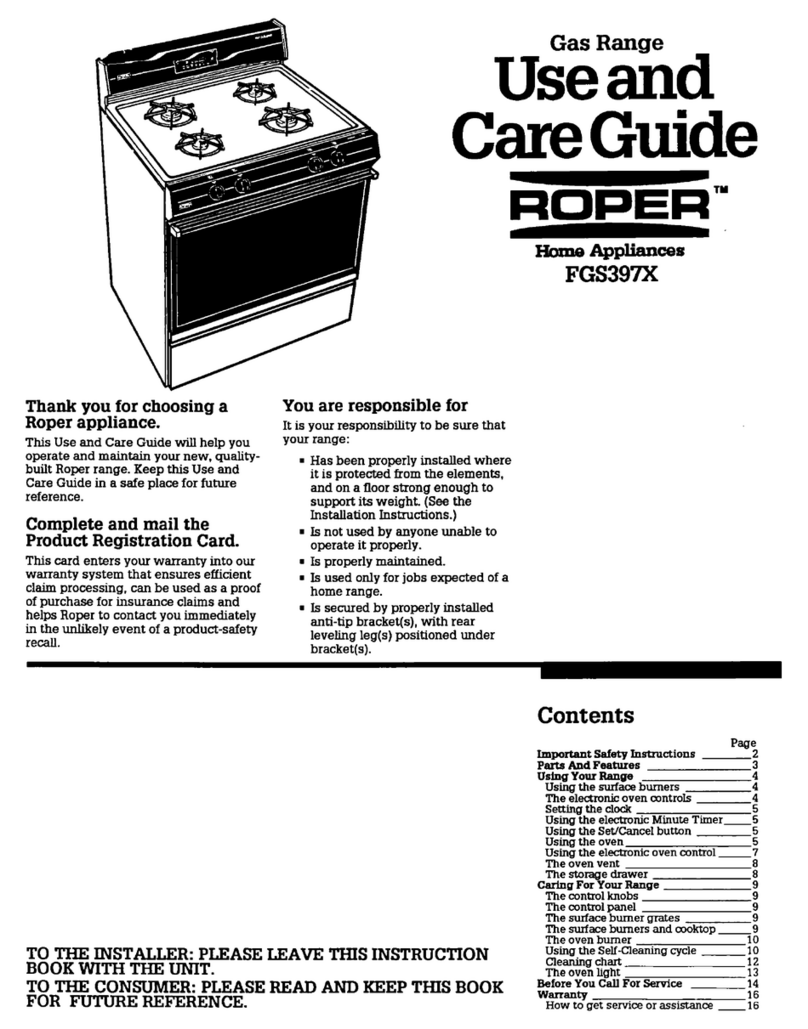
Roper
Roper FGS397X User manual
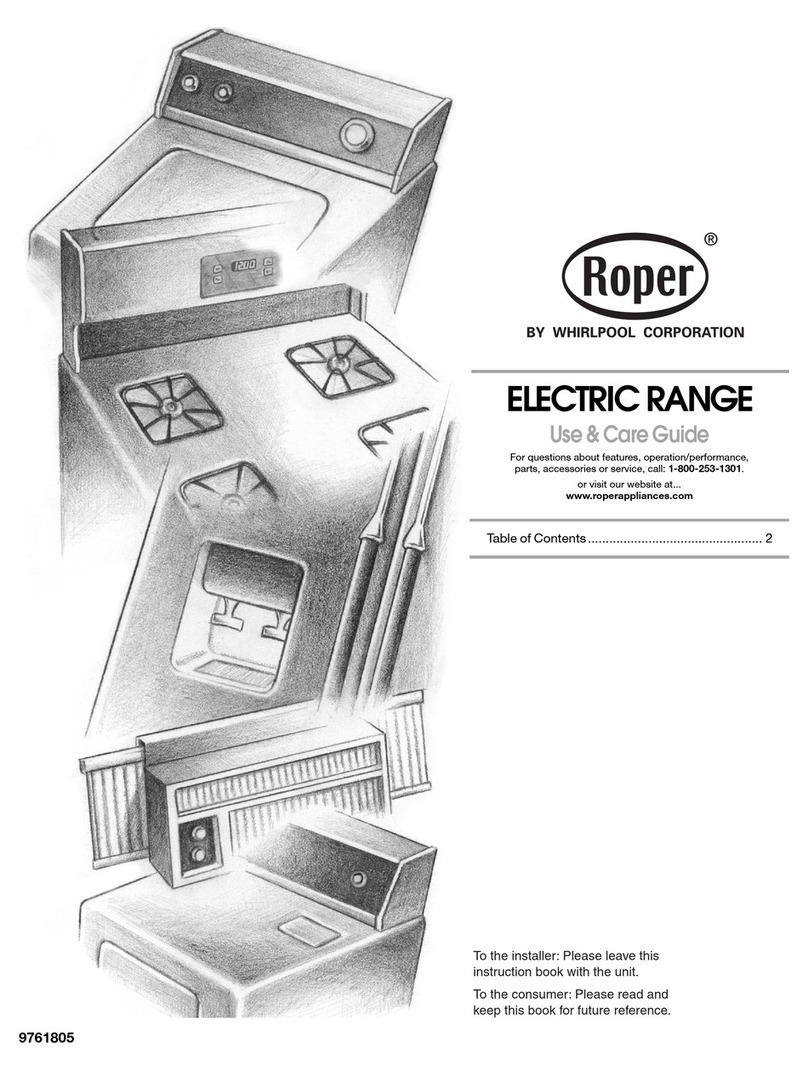
Roper
Roper 9761805 User manual

Roper
Roper FEP310G User manual
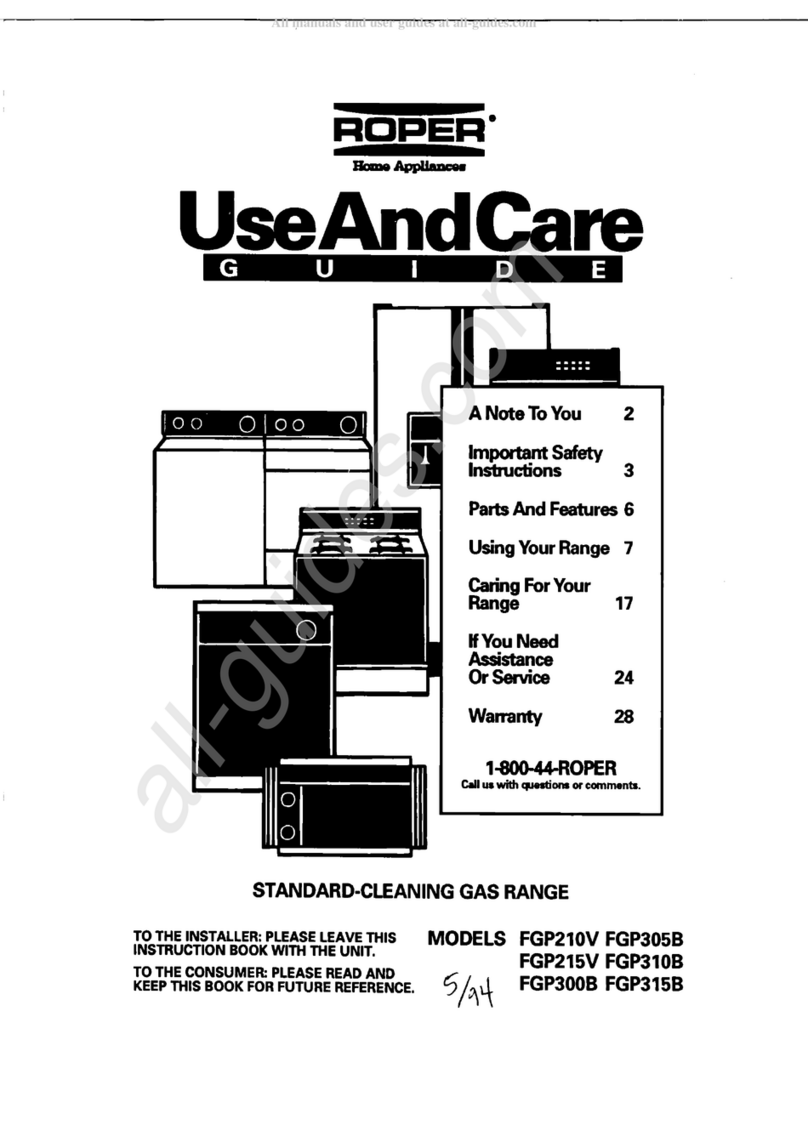
Roper
Roper FGP315B User manual

Roper
Roper REP34800 User manual
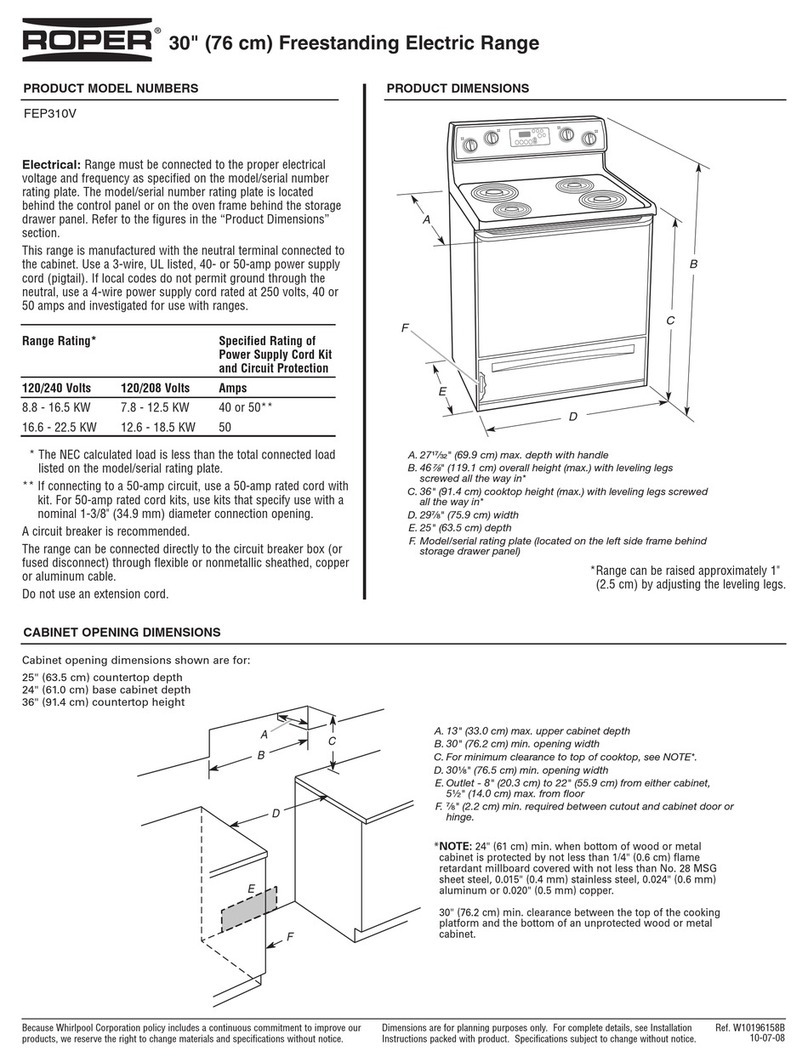
Roper
Roper FEP310V Parts list manual
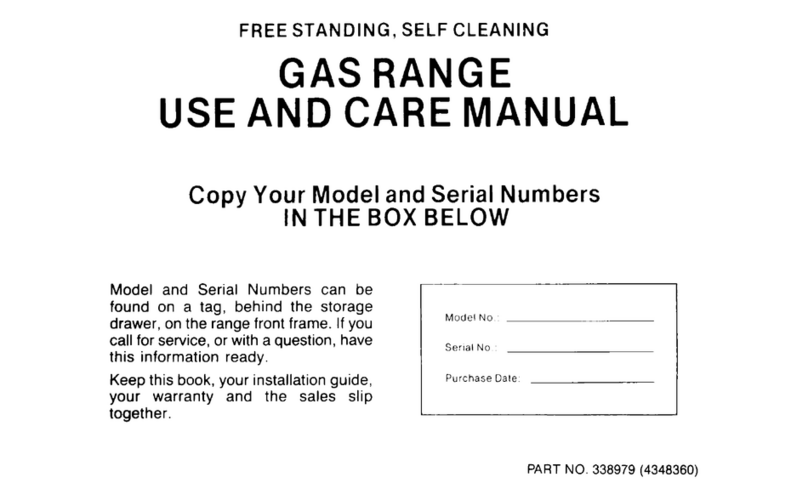
Roper
Roper F8858W0 User manual

Roper
Roper FGS385B User manual

Roper
Roper FEP310KW0 User manual

Roper
Roper FGS337G User manual
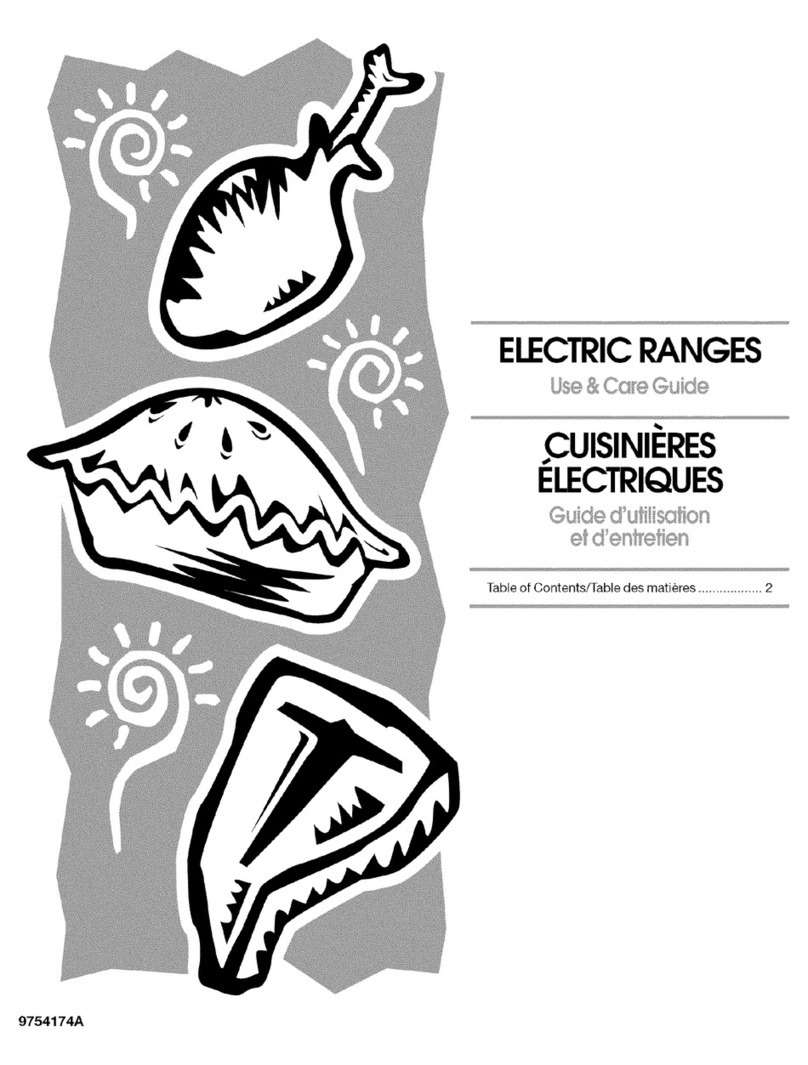
Roper
Roper REE32302 User manual
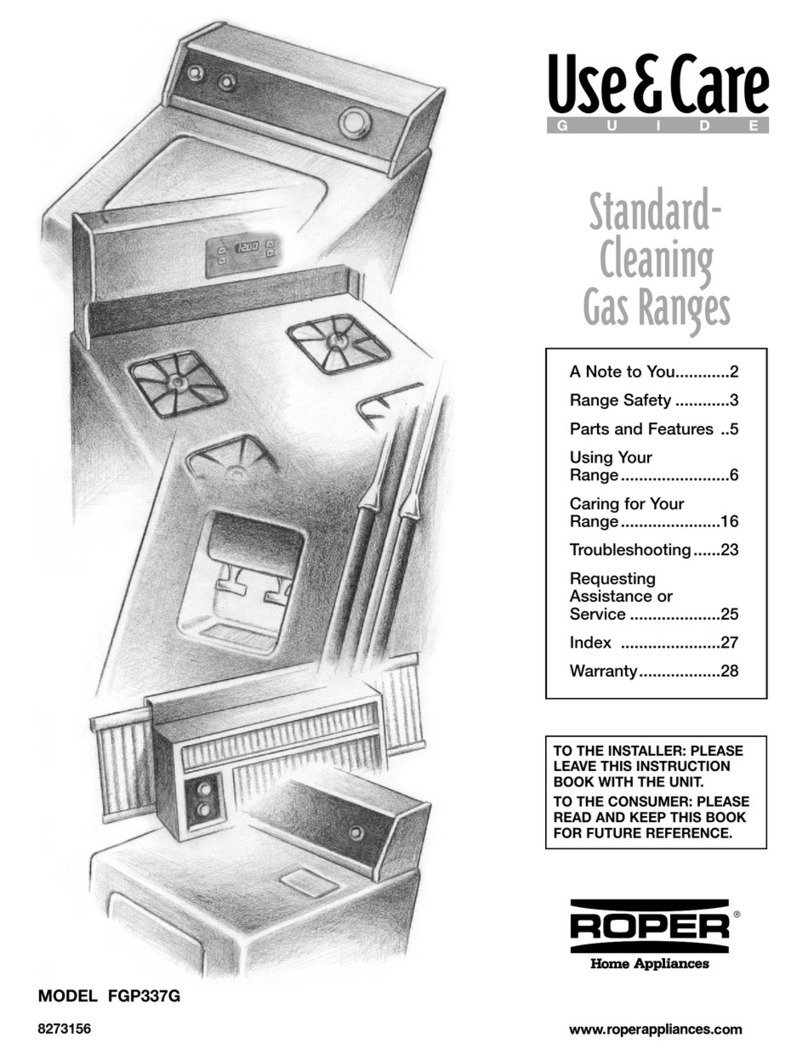
Roper
Roper FGP337G User manual

Roper
Roper FGP335B User manual
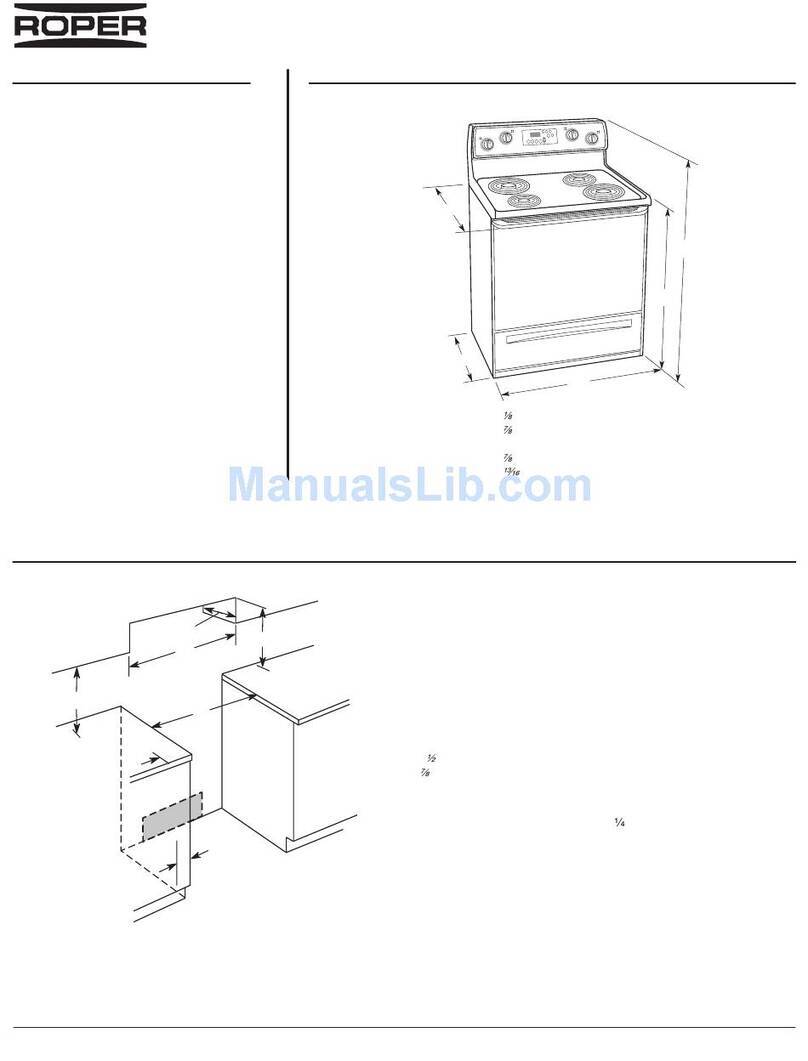
Roper
Roper FEP310KW User instructions

Roper
Roper FGP314TQ0 User manual

Roper
Roper W10017530 User manual
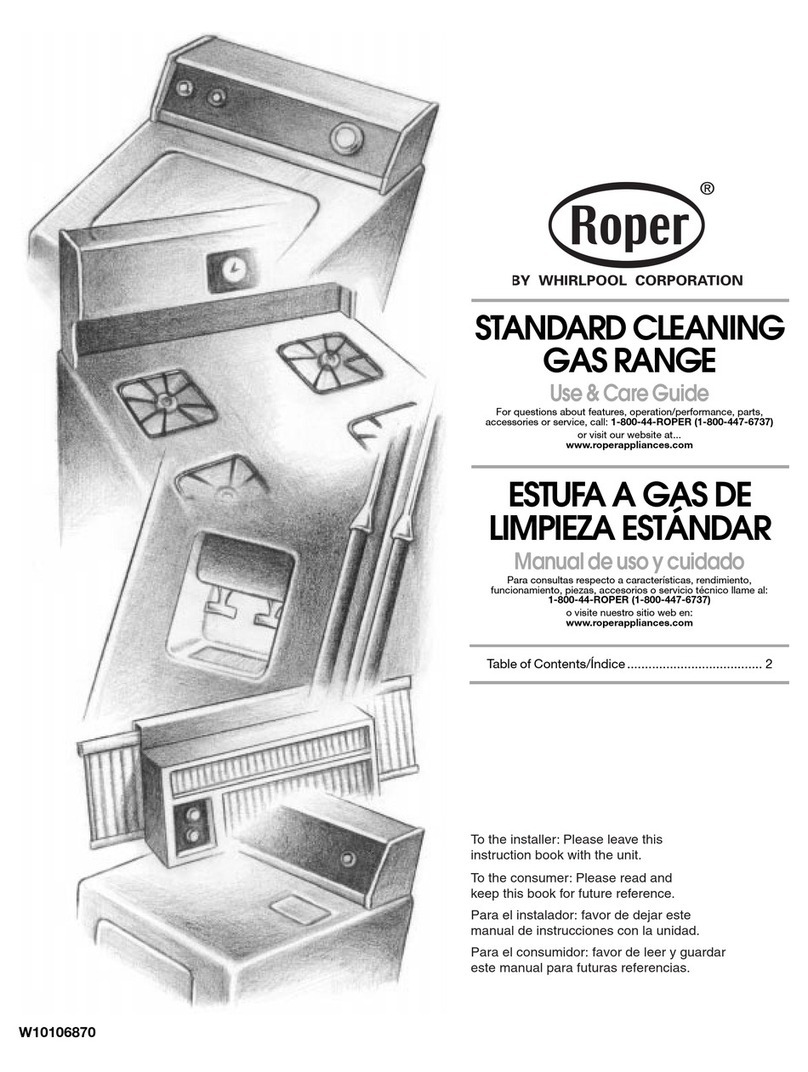
Roper
Roper W10106870 User manual

Roper
Roper FES310Y User manual
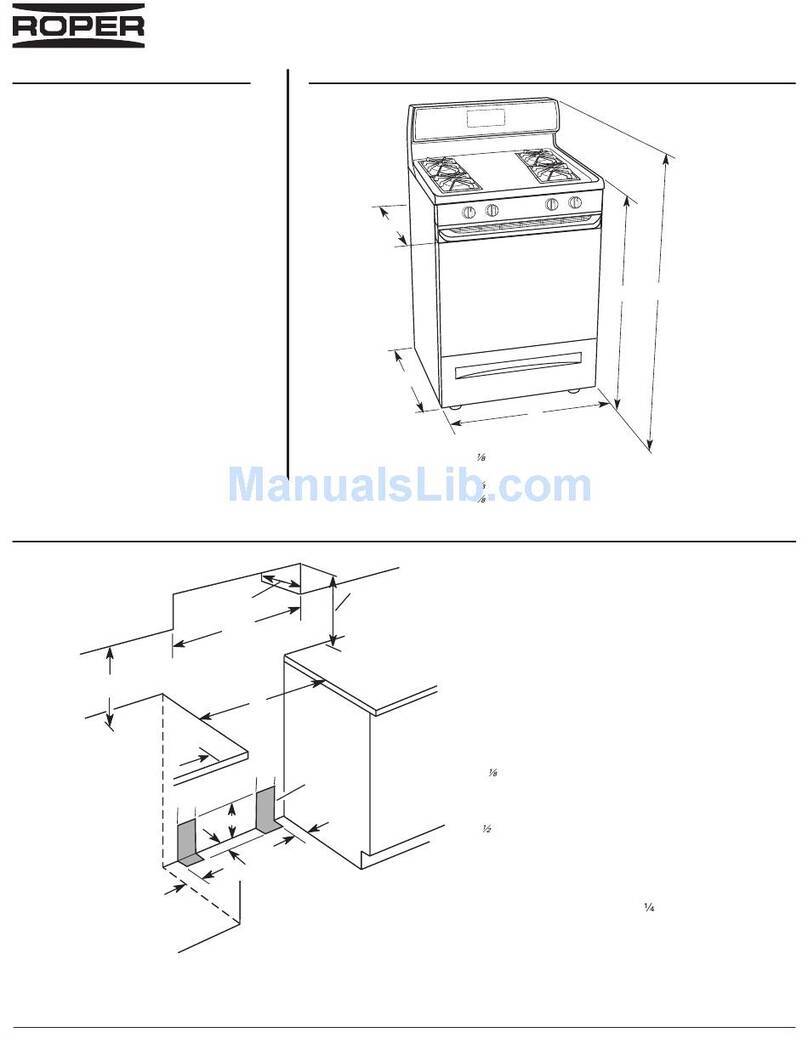
Roper
Roper FGS326RD User instructions
